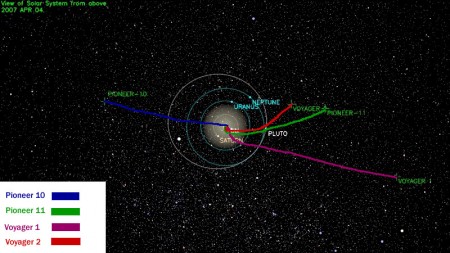Enceladus, one of Saturn’s moons, has geysers erupting water into space. The Cassini–Huygens spacecraft has taken some neat photos of the whole thing.
The Cassini–Huygens spacecraft itself is pretty interesting. It runs on three plutonium-powered radioisotope thermoelectric generators (RTGs). It flew past Venus twice to steal some momentum from the planet. It observed atmospheric circulation on Jupiter and performed tests to verify Einstein’s Theory of General Relativity.
To inject a touch of personal opinion, the Cassini–Huygens spacecraft shows how wonderful robots are for space exploration. If we sent humans to the relatively nearby destination of Mars, it would cost a fortune and quite possibly kill them. By contrast, some of our robot probes are already well beyond the boundary of the solar system, as defined by the orbits of the planets (and Pluto):
Image taken from Wikipedia.


It is worth noting that Alan Weisman’s extraordinary book The World Without Us describes how the probes outside the solar system may endure until the end of the universe.
Saturn moon could be hospitable to life
New detailed images of Saturn’s icy moon released this week provide the latest evidence that the surface may be hospitable to life.
NASA said on Tuesday that a flyby of planet’s Enceladus moon showed small jets of water spewing from the southern hemisphere, while infrared mapping of the surface revealed temperatures warmer than previously expected.
“The huge amount of heat pouring out of the tiger stripe fractures may be enough to melt the ice underground,” said John Spencer, a composite infrared spectrometer team member based at Southwest Research Institute in Boulder, Colo.
“Results like this make Enceladus one of the most exciting places we’ve found in the solar system.”
In the measurements, peak temperatures along Baghdad Sulcus exceed 180 Kelvin (minus 135 degrees Fahrenheit), and may be higher than 200 Kelvin (minus 100 degrees Fahrenheit).
“In 1997, we aimed a rocket towards Saturn and sent a 13-foot-wide satellite off on a mission to explore the strange worlds in our own (relative) backyard.
This month, NASA announced plans to extend the Cassini space probe’s Saturn sojourn until 2017—nine years longer than its original end date of 2008.
Why, exactly, does Cassini need those extra years? Most people probably know the mission best for the spectacular space photography it’s produced.
But NASA is hoping to get more than just a gallery of beautiful images out of extending the orbiter’s lifespan.
Armed with an array of 12 instruments—more than twice the number of science tools included on normal missions—Cassini is sort of a Swiss Army Knife in the sky.
As its mission continues, it will gather data that could help us pinpoint life-sustaining planets, or power our own with clean energy.”
‘‘When we started this, I realized we were on a mission of discovery,’’ he said. ‘‘I just had no idea how much discovery there was going to be. And I certainly had no idea that it would last as long as it has.’’ After we lose contact with them, the spacecraft will continue to orbit the galaxy for billions of years, never striking another star. ‘‘Space,’’ Stone said, ‘‘is really empty.’’
Why won’t Enceladus just freeze already?
Astronomers created a model for Saturn’s moon Enceladus that may explain why its subsurface ocean has yet to freeze solid.